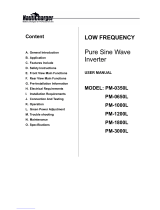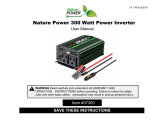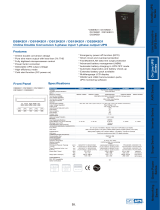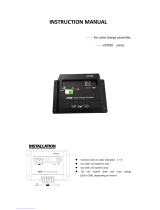
6 | SAMLEX AMERICA INC. SAMLEX AMERICA INC. | 7
Phase Angle, (φ): It is denoted by “φ” and species the angle in degrees by which the
current vector leads or lags the voltage vector in a sinusoidal voltage. In a purely induc-
tive load, the current vector lags the voltage vector by Phase Angle (φ) = 90°. In a purely
capacitive load, the current vector leads the voltage vector by Phase Angle, (φ) = 90°. In
a purely resistive load, the current vector is in phase with the voltage vector and hence,
the Phase Angle, (φ) = 0°. In a load consisting of a combination of resistances, induct-
ances and capacitances, the Phase Angle (φ) of the net current vector will be > 0° < 90°
and may lag or lead the voltage vector.
Resistance (R), Ohm, Ω: It is the property of a conductor that opposes the ow of cur-
rent when a voltage is applied across it. In a resistance, the current is in phase with the
voltage. It is denoted by "R" and its unit is "Ohm" - also denoted as "Ω".
Inductive Reactance (X
L
), Capacitive Reactance (X
C
) and Reactance (X): Reactance is the
opposition of a circuit element to a change of electric current or voltage due to that
element's inductance or capacitance. Inductive Reactance (X
L
) is the property of a coil
of wire in resisting any change of electric current through the coil. It is proportional to
frequency and inductance and causes the current vector to lag the voltage vector by
Phase Angle (φ) = 90°. Capacitive reactance (X
C
) is the property of capacitive elements to
oppose changes in voltage. X
C
is inversely proportional to the frequency and capacitance
and causes the current vector to lead the voltage vector by Phase Angle (φ) = 90°. The
unit of both X
L
and X
C
is "Ohm" - also denoted as "Ω". The effects of inductive reac-
tance X
L
to cause the current to lag the voltage by 90° and that of the capacitive reac-
tance X
C
to cause the current to lead the voltage by 90° are exactly opposite and the net
effect is a tendency to cancel each other. Hence, in a circuit containing both inductances
and capacitances, the net Reactance (X) will be equal to the difference between the
values of the inductive and capacitive reactances. The net Reactance (X) will be inductive
if X
L
> X
C
and capacitive if X
C
> X
L
.
Impedance, Z: It is the vectorial sum of Resistance and Reactance vectors in a circuit.
Active Power (P), Watts: It is denoted as “P” and the unit is “Watt”. It is the power that
is consumed in the resistive elements of the load. A load will require additional Reactive
Power for powering the inductive and capacitive elements. The effective power required
would be the Apparent Power that is a vectorial sum of the Active and Reactive Powers.
Reactive Power (Q), VAR: Is denoted as “Q” and the unit is VAR. Over a cycle, this power
is alternatively stored and returned by the inductive and capacitive elements of the load.
It is not consumed by the inductive and capacitive elements in the load but a certain
value travels from the AC source to these elements in the (+) half cycle of the sinusoidal
voltage (Positive value) and the same value is returned back to the AC source in the (-)
half cycle of the sinusoidal voltage (Negative value). Hence, when averaged over a span
of one cycle, the net value of this power is 0. However, on an instantaneous basis, this
power has to be provided by the AC source. Hence, the inverter, AC wiring and over cur-
rent protection devices have to be sized based on the combined effect of the Active and
Reactive Powers that is called the Apparent Power.
SECTION 2 | General Information























